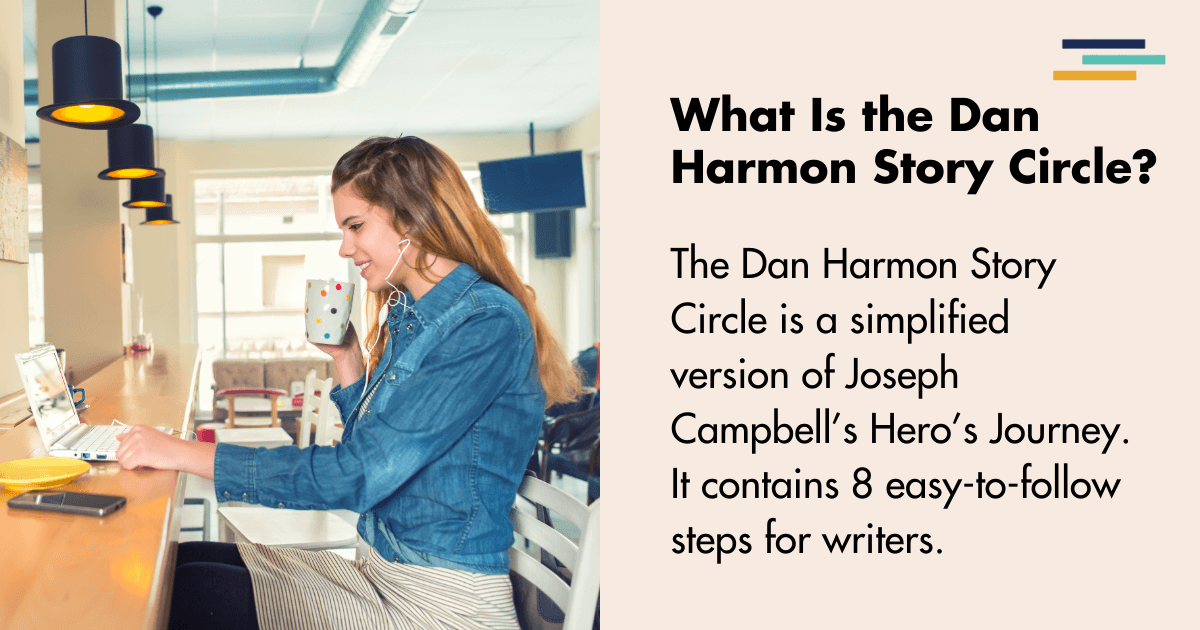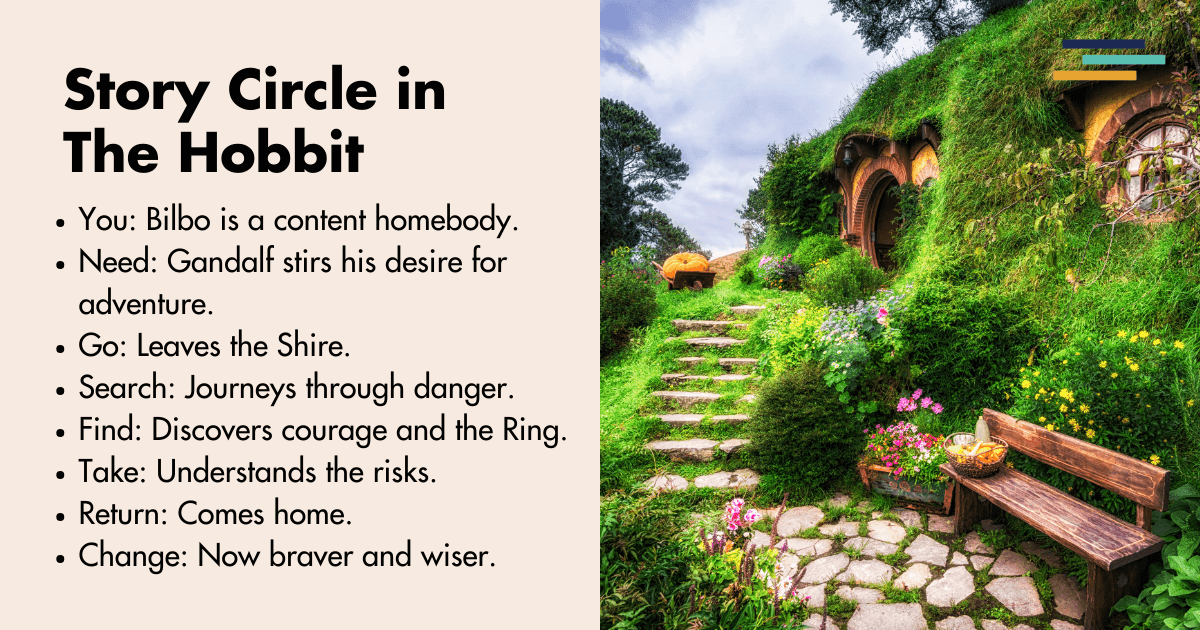
You know that satisfying moment in a story when everything just clicks? When the character has grown, the plot has come full circle, and you nod like, “Yep, that was a ride”?
Well, that’s no accident.
Dan Harmon, the creator of Rick and Morty and Community, is a master at delivering that feeling.
How?
He’s got a method up his sleeve called the Story Circle, and today, we’re diving into what it is, how it works, and how you can use it to give your own writing that narrative magic.
What is the Dan Harmon Story Circle?
The Dan Harmon Story Circle is a simplified version of Joseph Campbell’s Hero’s Journey.
Now, before you zone out at the mention of the Hero’s Journey, don’t worry. Harmon’s approach is like the SparkNotes version, but just as effective.
Harmon distilled the Hero’s Journey into eight easy-to-follow steps that help structure a story. Whether you’re working on a TV script, novel, or even a short story, the Story Circle ensures your narrative feels cohesive, balanced, and emotionally satisfying.
How Does the Story Circle Work?
At its core, the Story Circle is a storytelling tool that takes a character through a journey of change.
Harmon breaks the circle into two halves.
The top half represents the character’s comfort zone (their ordinary world), while the bottom half represents discomfort or chaos (the unknown).
The character starts off in their comfort zone, but to grow and change, they must descend into the unknown, face challenges, and return to their original world with newfound wisdom or a changed outlook.
Think of it like an emotional roller coaster.
Your character starts off thinking they’re ready for the ride, but by the time they reach the bottom of the loop, they’re gripping the handlebar for dear life.
By the end, they’ve gone through the highs and lows and are (hopefully) better for it. And, importantly, the story feels like a complete journey.

The 8 Steps of the Story Circle
Now, let’s break down the Story Circle into its eight steps. Each one plays a crucial role in guiding your character from start to finish, ensuring they don’t just meander aimlessly, but follow a clear path of growth.
1. You
The character exists in their world. This is where we meet the protagonist, usually in their ordinary environment.
Think of it as the calm before the storm. The “You” step is about establishing who the character is, what their world looks like, and what they want…
Or think they want.
This step is all about grounding the reader in your character’s life before the action kicks in.
2. Need
The character desires something. Now that we know who the character is, it’s time to identify what’s missing.
What do they want or need that will send them on their journey? It’s the itch they can’t quite scratch or the problem they need to solve.
Without this desire, the story would never move forward. It’s the equivalent of your character looking out the window and thinking, “There’s got to be more out there.”
3. Go
The character enters an unfamiliar situation. This is where the story really picks up. Your character is stepping out of their comfort zone and into the unknown.
Whether it’s a physical journey to a new place or an emotional shift, the character is now in unfamiliar territory. Here, the stakes rise, and the character has to face the reality of what they wanted.
4. Search
The character adapts to the situation. At this stage, the character is trying to make sense of their new world.
They’re searching for answers, allies, or resources to help them navigate their situation.
But, as we all know, nothing worth having comes easy, and this step is often full of trials, obstacles, and confusion.
5. Find
The character finds what they were looking for…
But there’s a catch.
This is the turning point where the character finally gets what they wanted, only to realize it’s not what they expected.
Maybe it’s more complicated than they thought, or maybe they realize they don’t actually want it after all. This step often marks the moment of truth for the character, where they must confront their deeper desires or fears.
6. Take
The character pays the price for what they’ve found.
Every choice has consequences, and in this step, the character must pay the cost of their actions.
Whether it’s a personal sacrifice, facing their fears, or accepting a harsh truth, this is where the stakes come to a head. Your character is now on the brink of transformation, but it’s going to cost them.
7. Return
The character returns to their familiar world, but they’re different. This step brings the character back to their ordinary life, but they’ve changed.
They carry the lessons they’ve learned or the scars they’ve earned. It’s the narrative equivalent of returning home from a long trip with souvenirs and a new outlook on life.
8. Change
The character has transformed. Finally, we reach the end of the circle, where the character has fully changed in some fundamental way.
They may have achieved their goal, but it’s who they’ve become in the process that matters most. This step completes the story’s emotional arc and leaves the reader with a sense of closure.

Story Circle Examples in Literature
Let’s look at how the Story Circle works in action with some famous examples from literature. These stories follow the eight steps, guiding characters through personal transformation and leaving readers with that satisfying full-circle feeling.
Bilbo Baggins in The Hobbit
Bilbo starts as a reluctant homebody, content in his cozy Hobbit hole (You), but he feels a pull toward adventure when Gandalf shows up with a band of dwarves (Need). He leaves his familiar Shire (Go) and embarks on a journey through treacherous lands (Search).
Along the way, he finds his courage and the One Ring (Find), but also realizes the dangers and responsibilities that come with it (Take). Bilbo eventually returns home (Return), but he’s no longer the same timid hobbit. He’s grown braver and wiser (Change).
Katniss Everdeen in The Hunger Games
Katniss begins in District 12, caring for her family (You). She’s thrust into the Games when she volunteers to take her sister’s place (Need), leaving her familiar world for the Capitol (Go). In the arena, she must adapt to survive (Search), forming alliances and making tough choices (Find).
She ultimately takes control of her fate by refusing to kill Peeta and tricking the Capitol (Take). When she returns home (Return), she’s a symbol of rebellion, forever changed by the Games (Change).
Harry Potter in Harry Potter and the Philosopher’s Stone
Harry lives in the mundane world with the Dursleys (You), but he learns he’s a wizard with a unique destiny (Need). He goes to Hogwarts (Go) and navigates the magical world (Search), making friends and enemies along the way. He finds out about the Sorcerer’s Stone and Voldemort’s plan (Find), and eventually risks his life to protect it (Take).
After defeating Quirrell/Voldemort, Harry returns to the Dursleys (Return), but he’s now a hero knowing that he belongs to a magical world (Change).
Elizabeth Bennet in Pride and Prejudice by Jane Austen
Elizabeth starts the novel as a sharp-tongued, independent woman (You), but there’s a glaring need in her life… to break free from societal expectations and find happiness (Need). She enters unfamiliar territory when she meets Mr. Darcy and navigates the tangled web of misunderstandings and social pressures (Go). As she gets to know Darcy, her assumptions are challenged (Search).
The moment of truth comes when she realizes her own prejudices (Find), and she confronts her pride by accepting her feelings for Darcy (Take). Elizabeth returns to her family (Return), but she’s no longer just the witty young woman we met. She’s found a balance between her independence and love (Change).
Tris Prior in Divergent by Veronica Roth
Tris begins her journey in Abnegation, living a quiet life of selflessness and modesty (You). But deep down, she feels the need for something more. She doesn’t quite fit into the self-sacrificing world she’s been born into (Need). She leaves her family and joins the bold, risk-taking Dauntless faction (Go), navigating their dangerous initiation rituals and discovering what it means to truly be brave (Search).
Along the way, she uncovers her divergence, a trait that makes her different from everyone else (Find), and realizes that this uniqueness puts her in grave danger (Take). By the end, Tris returns to the fight against the corrupt Erudite leaders (Return), but she’s now fully embraced her identity as Divergent, stronger and more self-assured than ever (Change).
Simba in The Lion King by Disney (Screenplay by Irene Mecchi, Jonathan Roberts, and Linda Woolverton)
Simba begins his life as a carefree lion cub with a future as king laid out before him (You). But after the traumatic death of his father, Mufasa, Simba feels the need to escape his past (Need). He runs away from the Pride Lands and meets Timon and Pumbaa in the jungle (Go). As Simba grows older, he understands the importance of his legacy (Search).
When Nala finds him and reminds him of his responsibilities, Simba realizes he can’t escape who he is (Find). He faces Scar in an epic showdown to reclaim the throne (Take). Simba returns as the rightful king (Return), but now he’s matured into a responsible leader, ready to rule (Change).
Santiago in The Alchemist by Paulo Coelho
Santiago starts as a simple shepherd (You) with dreams of finding a hidden treasure (Need). He leaves his familiar life behind to embark on a quest through the desert (Go). Along the way, he meets various mentors and learns about the mystical concept of the “Personal Legend” (Search).
Santiago finally reaches the pyramids, where he realizes that the treasure was never a physical one, but the wisdom he gained on the journey (Find). In the end, he returns home (Return), transformed by the realization that the answers were within him all along (Change).
Dorothy Gale in The Wizard of Oz by L. Frank Baum
Dorothy starts off in Kansas, feeling like there’s something more out there for her (You). A tornado hits, and suddenly she’s in the strange land of Oz (Go). Dorothy searches for the Wizard to help her return home (Search), but along the way, she learns that she’s already got the power to return… thanks to her ruby slippers (Find).
She faces the Wicked Witch, takes her broom, and gains the courage she didn’t know she had (Take). Dorothy returns home to Kansas (Return), and though nothing in Kansas has changed, Dorothy herself has. She now understands that there’s no place like home (Change).
Marjane Satrapi in Persepolis by Marjane Satrapi
In the autobiographical graphic novel Persepolis, Marjane starts off as a young girl living in Tehran during the Iranian Revolution (You). As the political unrest grows, she feels the need to understand her identity and her place in the world (Need). She moves to Europe, leaving her familiar home behind (Go).
Through a series of trials and personal growth in a foreign land (Search), Marjane eventually realizes that her identity is tied to her homeland, no matter how far she runs (Find). She faces the cost of reconciling her heritage with her modern identity (Take). When she returns to Iran (Return), she’s changed—more worldly, but still connected to her roots (Change).
Offred in The Handmaid’s Tale by Margaret Atwood
Offred starts in Gilead, a dystopian society where women’s rights are nonexistent (You). She yearns for freedom, both physically and mentally, as she struggles with her oppressive circumstances (Need). As she navigates the rules of this harsh regime (Go), she seeks small acts of rebellion (Search).
When she learns of the resistance and starts taking part, she finds a sense of purpose (Find). The risks she takes, however, come at a high price (Take). By the end, she’s ready to escape Gilead and leave the horrors behind (Return), but she’s forever altered by the trauma and loss she’s endured (Change).
Tips For Using the Story Circle
If you’re ready to give the Story Circle a whirl, here are some tips to help you apply this method to your own writing.
Start with Character Motivation
Before you plot, think about what your character wants.
Every journey begins with a desire. Whether it’s saving the world, finding love, or just getting through the day without embarrassing themselves. Nail down your character’s motivation before jumping into the Circle.
Keep the Stakes High
Don’t let your characters get too comfortable.
Once they leave their familiar world, make sure the stakes rise with each step. The bigger the obstacles, the more satisfying the payoff when they finally complete their journey.
Use Each Step to Build Emotional Depth
The Story Circle isn’t just about physical actions. It’s about emotional growth.
Each step should push your character toward self-discovery or challenge their core beliefs. The more emotionally invested the reader is, the more powerful the journey will feel.
Remember, Change is Key
At the end of the Circle, your character needs to have changed.
Whether it’s a major transformation or a subtle shift in perspective, the Circle is about growth. If your character ends the story exactly where they started, something’s missing
Focus on the Emotional Journey
While the Story Circle is great for outlining your plot, don’t forget that it’s the emotional journey that really hooks readers. Every step of the Circle should reflect not only what’s happening in the story, but also what’s happening inside your character’s head.
As your character ventures into the unknown, what emotions are they battling? Fear? Guilt? Excitement?
The external action should mirror the internal struggle to create a more well-rounded, interesting narrative. If your character’s only growth is learning how to fight with a sword, you’re missing out on the emotional depth that readers crave.
Keep the Pace Varied
Just because the Story Circle has eight steps doesn’t mean each one needs to get equal page time.
Some steps may fly by, like the moment your character realizes they need to leave their comfort zone, while others, like their internal struggles in the “Search” phase, might take longer to unfold.
Mix up the pacing to keep readers engaged.
And finally, always remember that the story comes first. Focus on:
- Creating engaging characters
- Penning interesting plots
- Structuring solid settings
A tool like Fictionary helps you turn your draft into an interesting story readers love. So, with a strong narrative foundation, your writing can truly shine.

